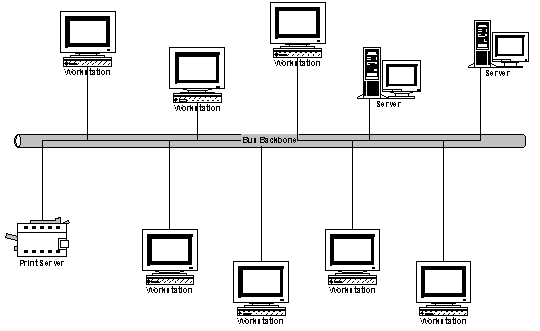
Type of Network
Common Bus Topology

The above figure shows a common bus topology (or simply bus topology) connecting devices such as print server, workstations and servers. The communicate through a single bus (one or more parallel lines) A common approach gives each device an interface that listens to the bus and examines its data traffics. If an interface determines that data is destined for the device it serves, it reads the data from the bus and transfers it to the device. Similarly, if a wants to transmit data, the interface circuits sense when the bus is empty and the transmit data. this is not unlike waiting on a freeway entrance ramp during rush hour. You sense an opening and either quickly dart it to or "muscle" your way through, depending on whether you're driving a subcompact or a large truck.
Sometimes, two devices try to transmit simultaneously. each one detects an absence of traffic and begins transmitting before becoming aware of the other device's transmission. The result is a collision of signals As the devices transmit, they continue to listen to the bus and detect the noise resulting from the collision. When a device detect collision, it stops transmitting, wait a random period of time , and tries again. This process is called Carrier Sense, Multiple Access with Collision Detection (CSMA/CD) is discussed along with other ways to access common media.
One popular common bus network is Ethernet. Its common bus typically is the Ethernet cable whereby is normally used for a bus topology, which consists of copper, optical fiber combinations of both (although recent developments allow connection using microwave and infrared technology). Its design allows terminals, Pc's, disk storage systems, and office machines to communicate. A major advantage of the Ethernet is the ability to add new devices to the network easily.
Common Star Topology.
Another common connecting arrangement is the Star Topology (as you seen below). It uses a central hub or switch that communicates with either devices in the network. Control is centralized; if a device want to communicate, it does so only through the central hub or switch. The hub or switch, in turn, routes the data to its destination. Centralization provide a focal point to responsibility, an advantage of the star topology. The bus topology, however, has some advantages over a star topology. The lack of central control makes adding new devices easy since no device must be aware of others. In addition, the failure or removal of a device in a bys network does not cause the network to fail. In the star topology, the failure of the central hub or switch bring down the entire network.
Star topology often involve a single mainframe computer that services many terminals and secondary storage devices. With appropriate terminal emulation software, Pc's can communicate with it. Data transfers between terminals or between terminals and storage devices (such as file server) occur only the main hub or switch.

Common Ring Topology.
In a ring topology (as below) devices are connected circularly. Each one can communicate directly with either or both of its neighbors but nobody else. If it wants to communicate with a device farther away, it sends a message that passes through each device in between.
A ring network may be either unidirectional or bi-directional. Unidirectional means that all transmissions travel in the same direction. Thus, each device can communicate with only one neighbor. Bi-directional means that data transmissions travel in either direction, and a device can communicate with both neighbors.
Ring topologies such as IBM's token ring network often connect PCs in a single office or department. Applications from one PC thus can access data stored on others without requiring a mainframe to to coordinate communications. Instead, communications are coordinated by passing a token (predefined sequences of bits) among all the stations in the rings. A station can send something only when it receives the token .
A disadvantage of the ring topology is that when one station sends to another , all station in between are involved. More time is spent relaying messages meant for others than in, for example, a bus topology. Moreover, the failure of one stations causes a break in the ring which affects communications among all the stations.

Common Ring Topology